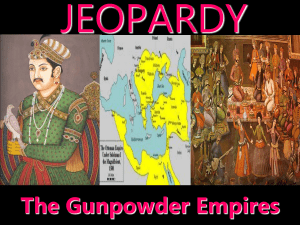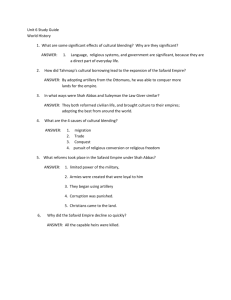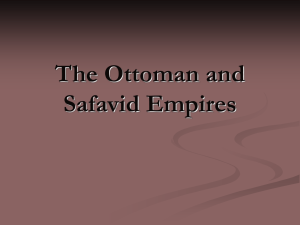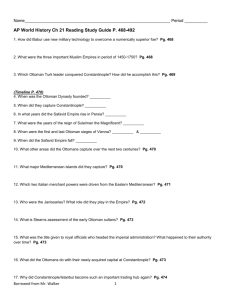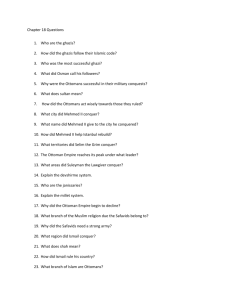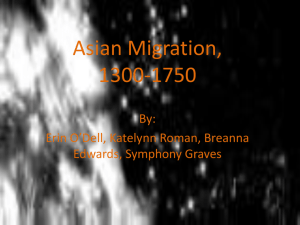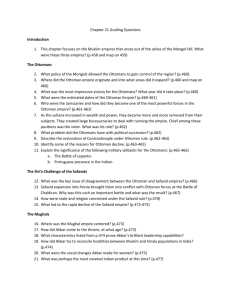Chapter 21: The Muslim Empires
advertisement
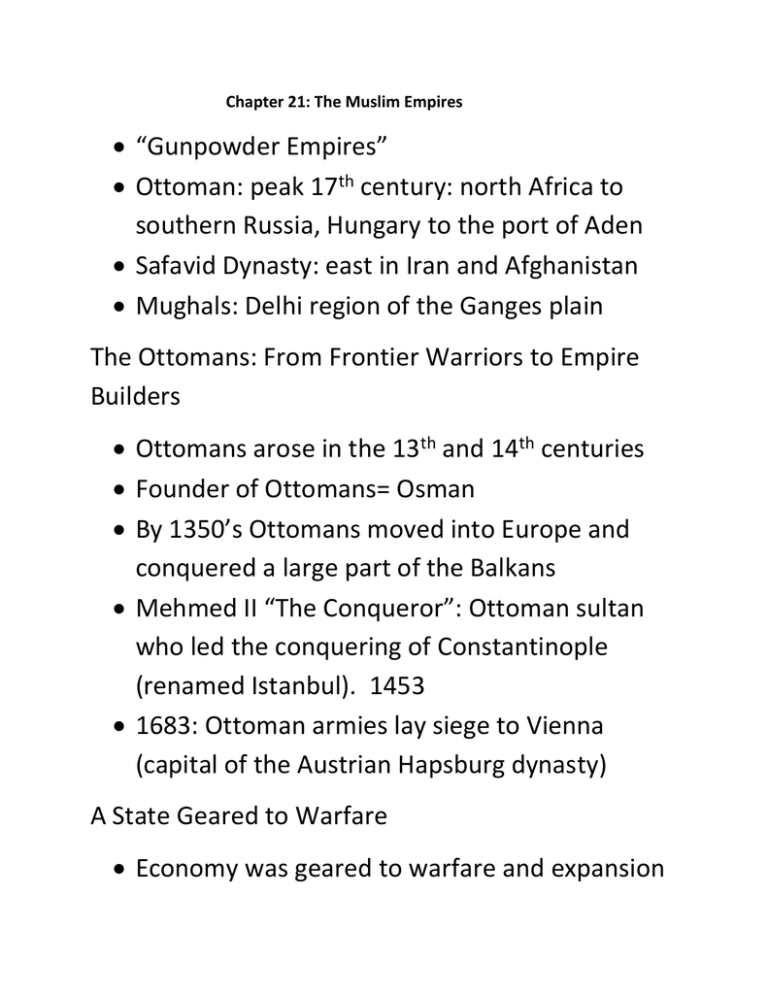
Chapter 21: The Muslim Empires “Gunpowder Empires” Ottoman: peak 17th century: north Africa to southern Russia, Hungary to the port of Aden Safavid Dynasty: east in Iran and Afghanistan Mughals: Delhi region of the Ganges plain The Ottomans: From Frontier Warriors to Empire Builders Ottomans arose in the 13th and 14th centuries Founder of Ottomans= Osman By 1350’s Ottomans moved into Europe and conquered a large part of the Balkans Mehmed II “The Conqueror”: Ottoman sultan who led the conquering of Constantinople (renamed Istanbul). 1453 1683: Ottoman armies lay siege to Vienna (capital of the Austrian Hapsburg dynasty) A State Geared to Warfare Economy was geared to warfare and expansion Turkic cavalry became a warrior aristocracy Janissaries: conscripted as adolescents, initially Christian, then converted (DEVSHIRME System) o Elite fighting force o Also involved in court politics The Sultans and Their Court Even most powerful sultans had to play groups off of one another (warrior elite vs. janissaries) Muslim traders/ Christian and Jewish merchants Dhimmis “people of the Book” Large Bureaucracy Grand Vizier (wazir) overall head of the imperial administration Constantinople Restored and the Flowering of Ottoman Culture Church of Hagia Sophia (Holy Wisdom) was converted to a mosque Aqueducts added, city was restored Suleymanieye mosque: one of the great engineering achievements of Islamic Civilization Suleyman the Magnificent (r. 1520-1566): Most successful of the Ottoman Sultans, nicknamed “the Lawgiver” Sizable merchant and artisan classes in Constantinople Artisans were organized into Guilds Transition to Turkish language Key Exports: COFFEE and CERAMICS The Problem of Ottoman Decline Eventually known as the “sick man” of Europe in 18th and 19th centuries At the height of its power, the Ottoman Empire was too large to be maintained Corruption by many local officials who squeezed the peasants and laborers for additional taxes and services Peasant rebellions Princes: no longer trained in military, kept sequestered in palace Military Reverses and the Ottoman Retreat Ottomans relied on huge siege guns while Europe started using light field artillery Battle of Lepanto: 1571- between Ottomans and combined Spanish and Venetian fleet. Ottomans lost. Known as one of the greatest sea battles in history. Rammed ships into each other. Ottomans were also not able to prevent Portuguese expansion into the Indian Ocean in the 1500’s Inflation in Ottoman Empire caused by influx of New World Silver The Shi’a Challenge of the Safavids Founded in what is today Iran Center of Shi’ism in the Islamic World 1722: end of Safavid Empire Shi’a believed that only the fourth successor (Ali, Mohammed’s cousin and son-in-law) had the right to succeed the prophet. Long rivalry developed between the Sunni Ottomans versus Shi’a Safavids Safavid Dynasty began in early 14th century by Sail al-Din, a Sufi mystic. Began a militant campaign to purify and reform Islam and spread Muslim teachings among the Turkic tribes of the region. Red Heads: followers of Safavids Isma’il: military leader who led his Turkic followers to string of victories and in 1501 conquered the city of Tabriz, proclaimed shah, or emperor Battle of Chaldiran, August 1514, between the Ottomans and Safavids, use of muskets and field cannons, Safavids were beat by the Ottomans led by Selim the Grim. o Result: Shi’ism was confined largely to Persia, or present-day Iran, and neighboring areas in what is today southern Iraq. Politics and War Under the Safavid Shahs Tahmasp I (r. 1534-1576) tried to restore the power of the Safavid Dynasty Shah Abbas I (r. 1587-1629) also known as Abbas the Great, the empire reached the height of its strength and prosperity. Created slave regiments from Russian youths who were educated and converted to Islam. Empire became center of international trade and Islamic culture. Infrastructure: roads and rest houses. Safavid warrior nobles were assigned villages, whose peasants were required to supply them and their troops with food and labor Persians were recruited for the bureaucracy to balance the power of the Warrior elite Use of slave regiments State and Religion Persian became the language of the court and bureaucracy Rulers Claimed descent from one of the Shi’a imams Mullahs: local mosque officials and prayer leaders, supervised by the state Shi’ism became dominant religion, others were pressured to convert Elite Affluence and Artistic Splendor Abbas I encouraged trade Capital at Isfahan: several colleges, public baths and rest houses, workshops Great Mosques at Isfahan Decoration: Geometric designs (arabesque), floral patterns, and verses from the Qur’an (calligraphy) Society and Gender Roles: Ottoman and Safavid Comparisons Dominated by warrior aristocracies: shared power with the absolutist monarchs of each empire Growth of handicraft production and trade in their realms Public Works Projects Women faced legal and social disadvantages compared to other areas: subordinated to their fathers and husbands. Practices of seclusion and veiling especially among the elites Many women were involved in trade and money-lending Women could use court system to protect their rights to inheritance and divorce The Rapid Demise of the Safavid Empire Abbas killed or blinded all who could legitimately succeed him. o Weak grandson was put on throne following Abbas’ death (easily manipulated) March 1722: Isfahan was besieged by Afghani tribes…by October, 80,000 of capital’s inhabitants died from starvation and disease, city fell and Safavid power was ended.\ Nadir Khan Afshar: emerged as leader and proclaimed himself shah in 1736. The Mughals and the Apex of Muslim Civilization in India Babur: founder of the Mughal dynasty. Traced decent from Mongol khans and Tamerlane. Led his followers into India in 1526 because he lost his original kingdom. Babur used gun carts, movable artillery, and cavalry techniques to defeat the Muslim Lodi dynasty o Also frightened the war elephants Babur conquered large portions of the Indus and Ganges plains Babur: wrote a history of India, musician, gardens, patron of arts Hamayan: son and successor to Babur in 1530. Forced to flee to Persia by 1540…and remained in exile Akbar and the Basis for a Lasting Empire Akbar: son of Hamayan, became ruler at 13. One of the greatest leaders of all of history. Strong Military and Bureaucracy o Patron of arts o Took charge of government in 1560 o Encouraged intermarriage between Hindus and Mughal aristocracy. o Abolished the jizya (head tax) o Promoted Hindus to highest ranks in government o Ordered Muslims to respect cows o Din-i-Ilahi: new faith created by Akbar. Tried to unite his Hindu and Muslim subjects Social Reform and Social Change Akbar tried to improve calendar, take care of beggars, and regulate consumption of alcohol. Encouraged widow remarriage and discouraged child marriage Legally prohibited SATI Special market days for women to counteract Purdah (seclusion) Mughal Splendor and Early European Contacts Jahangir (r. 1605-1627) Shah Jahan (r. 1627-1658) By late 17th century, India was as major destination for European traders Cotton/ Indian Textiles important Artistic Achievement in the Mughal Era Tolerance towards Hindu majority Jahangir and Shah Jahan were remembered as great patrons of the arts Taj Mahal: built by Shah Jahan as a tomb for his wife, Mumtaz Mahal. Court Politics and the Position of Elite and Ordinary Women Nur Jahan: Jahangir’s wife who wielded a lot of power. Died giving birth to their 19th child. Mumtaz Mahal: consort of Shah Jahan..much loved by Shah Jahan Seclusion was more strictly enforced for uppercaste women, both Hindu and Muslim Child marriage continued as young as 9 The Beginnings of Imperial Decline Arangzeb: Shah Jahan’s son and successor o Wanted to extend Mughal control over the whole Indian subcontinent o Wanted to purify Indian Islam o Series of long wars that bankrupt the country o Reinstated the head tax on unbelievers Sikhs: new religious sect that initially tried to bridge the differences between Hindus and Muslims…but were persecuted and eventually became anti-Muslim Old Book: Chapter 16: The Muslim Empires The Ottoman Empire led by Osman (1280-1326) Anatolian peninsula- Bosporus and Dardanelles Beys: provincial governors in the Ottoman Empire Janissaries: recruited from local Christian population- converted to Islam and became an elite fighting force Mehmet II- successfully conquered Constantinople in 1453-renamed Istanbul Selim: Defeated the Safavids, gaining territory in Mesopotamia Selim: Defeated the Mamluks, gaining territory in Syria and Egypt o Selim declared himself a caliph Ottomans eventually lost power in North Africa Suleyman I the Magnificent (1520-1566): greatest of the Ottoman sultans- Ottomans overran most of Hungary, and into Austria Turkish Rule: o “gunpowder empires”= important success due to mastery of firearms o Sultan: supreme authority: politically and militarily o Beys: Tribal leaders Booty: taxes o Eventual Hereditary rule w/ Sultans (execution common w/ silk bowstring) o Topkapi Palace :Istanbul o Harem “sacred place”: private domain of sultan and his concubines Concubine’s status increased if gave birth to a son…if their son became sultan, they became “Queen mother” and were an advisor to the throne. Members of the harem were often of slave origin: by 15 th c. royal heirs were exclusively from slave mothers Harem more like a nunnery than brothel Nickname “Sultanate of Women” “Devshirme” System: prisoners provided to sultan as part of taxation, Muslims could not be slaves, that is why they were usually Christian children opportunity for women and men to be educated o Grand Vizir= Chief advisor o Empire divided into provinces Religion and Society in Ottoman world o Sunni Muslims o Ottoman sultans also claimed title of Caliph o Non-Muslims paid a head tax Organized in religious administrative units called Millets Own justice system, education, and welfare- reported to the sultan o Women could own and inherit property Ottomans in Decline o KEY exports of Ottomans: coffee and ceramics o Suleyman executed two of his sons and his remaining heir, Selim II was not very popular o Corruption in taxation o Trade routes were being diverted away from the Med. Sea Ottoman Art o Craft guilds o Architecture: mosques- ceramic tile The Safavids 1501-1723 founded by Shah Ismail- traced origins to Ali- 4th imam of the Muslim faith followed Shi’i Islam o followers were called “red heads” b/c of their distinctive red caps w/ 12 folds symbolizing the 12 imams of the Shi’i faith conquered territory from Baghdad to Bokhara to Anatolia Shah Abbas I (1587-1629) o Lost territory to the Ottomans o Created a traditional warrior elite Safavid Politics and Society o Iran o Used Shi’ite faith as a unifying force o Shah claimed to be spiritual leader of all Islam o Meritocracy Art and Literature o Abbas capital= Isfahan o Architecture- ornate o Textiles: Silk and carpet weaving The Mughals 16th to 18th Century India “Gunpowder Empire”? o Founder Babur (1483-1530) Descended from Tamerlane and Genghis Khan Had advanced weapons and a mobile calvary Son= Hamayun o Akbar (1556-1605) Brought Mughal rule to most of the subcontinent Heavy artillery vs. “carrot and stick” (negotiations) Religious toleration Divine Faith (Din-I-Ilahi) combined characteristics of several religionscentral concept of infallibility of emperor Zamindars: officials given agricultural land and they kept part of the taxes as their payment Muslims: Islamic law (Shari’ah), Hindu law (the Dharmashastra) o Shah Jahan Grandson to Akbar Executed all his rivals to secure throne Famine, treasury empty Built the Taj Mahal for wife Mumtaz Mahal o Aurangzeb Decline of empire Outlawed sati, castration of eunuchs, but reinstated measures against Hindus Western European Powers in India 1st Portuguese 16th c. English and Dutch British power grew in India while Mughal power waned Sir Robert Clive: chief representative of the East India Company on subcontinent: Society and Culture Under the Mughals Muslim, Hindu and Persian influences Women: weaving, property rights Purdah, sati, child marriage Ramayana in vernacular o Tulsides wrote Ramacaritmanas-devotional story w/ deified Rama and Sita
